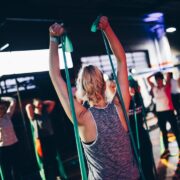
Boost Athletic Performance with CrossFit Training
CrossFit training has gained popularity in recent years as a comprehensive and effective approach to athletic performance enhancement. It combines elements of strength training, endurance training, agility and coordination training, and mental preparation to help athletes reach their full potential. In this article, we will explore the benefits of CrossFit training for athletes, the different components of CrossFit training, and how it can be incorporated into an athlete’s training plan.
Key Takeaways
- CrossFit training can enhance athletic performance by improving strength, endurance, agility, coordination, and mental preparation.
- The comprehensive approach of CrossFit training can benefit athletes by targeting multiple aspects of fitness.
- Strength training is a crucial component of CrossFit training for athletic performance enhancement.
- CrossFit training can improve endurance and stamina through high-intensity interval training and metabolic conditioning.
- CrossFit training can enhance agility and coordination through functional movements and varied workouts.
The Benefits of CrossFit Training for Athletes
1. Increased strength and power: One of the key benefits of CrossFit training for athletes is the improvement in strength and power. By incorporating weightlifting exercises, such as squats, deadlifts, and cleans, athletes can build muscle mass and increase their overall strength. This increased strength translates into more power during explosive movements, such as sprinting or jumping.
2. Improved endurance and stamina: CrossFit training also focuses on improving endurance and stamina through high-intensity interval training (HIIT) workouts. These workouts involve short bursts of intense exercise followed by periods of rest or lower intensity exercise. This type of training helps athletes improve their cardiovascular fitness and increase their ability to sustain high levels of effort for longer periods of time.
3. Enhanced agility and coordination: CrossFit training incorporates a variety of functional movements that require agility and coordination. Exercises such as box jumps, burpees, and kettlebell swings help athletes improve their ability to move quickly and efficiently, while maintaining control over their body movements. This can be particularly beneficial for sports that require quick changes in direction or precise movements.
4. Injury prevention and rehabilitation: Another advantage of CrossFit training for athletes is its focus on injury prevention and rehabilitation. The emphasis on proper form and technique during exercises helps athletes develop good movement patterns and reduce the risk of injury. Additionally, many CrossFit workouts include exercises that target specific muscle groups or joint mobility, which can help prevent or rehabilitate common sports-related injuries.
5. Mental preparation for athletic performance: CrossFit training also places importance on mental preparation for athletic performance. The high-intensity nature of the workouts pushes athletes to their limits, helping them develop mental toughness and resilience. This mental strength can be invaluable during competition, as athletes are better able to handle pressure and perform at their best.
CrossFit Training: A Comprehensive Approach to Athletic Performance
CrossFit training takes a comprehensive approach to athletic performance by incorporating various components that are essential for overall improvement. These components include strength training, endurance and stamina training, agility and coordination training, nutrition, injury prevention and rehabilitation, and mental preparation.
1. Strength training: Strength training is a fundamental component of CrossFit training. It involves exercises that target specific muscle groups to build strength and power. These exercises often involve lifting weights or using resistance bands, and can include movements such as squats, deadlifts, bench presses, and overhead presses. By increasing muscle mass and improving overall strength, athletes can generate more power during explosive movements.
2. Endurance and stamina training: CrossFit training also focuses on improving endurance and stamina through high-intensity interval training (HIIT) workouts. These workouts involve short bursts of intense exercise followed by periods of rest or lower intensity exercise. This type of training helps athletes improve their cardiovascular fitness and increase their ability to sustain high levels of effort for longer periods of time.
3. Agility and coordination training: CrossFit incorporates a variety of functional movements that require agility and coordination. Exercises such as box jumps, burpees, kettlebell swings, and ladder drills help athletes improve their ability to move quickly and efficiently, while maintaining control over their body movements. This can be particularly beneficial for sports that require quick changes in direction or precise movements.
4. Nutrition: CrossFit recognizes the importance of nutrition in athletic performance. Proper nutrition provides the fuel necessary for optimal performance and aids in recovery. CrossFit encourages athletes to follow a balanced diet that includes lean proteins, complex carbohydrates, healthy fats, and plenty of fruits and vegetables. It also emphasizes the importance of staying hydrated and avoiding processed foods and sugary drinks.
5. Injury prevention and rehabilitation: CrossFit training places a strong emphasis on injury prevention and rehabilitation. The focus on proper form and technique during exercises helps athletes develop good movement patterns and reduce the risk of injury. Additionally, many CrossFit workouts include exercises that target specific muscle groups or joint mobility, which can help prevent or rehabilitate common sports-related injuries.
6. Mental preparation: CrossFit recognizes the importance of mental preparation in athletic performance. The high-intensity nature of the workouts pushes athletes to their limits, helping them develop mental toughness and resilience. CrossFit also incorporates mindfulness techniques, such as breathing exercises and visualization, to help athletes stay focused and perform at their best.
The Importance of Strength Training in CrossFit for Athletic Performance
| Metrics | Description |
|---|---|
| Increased Muscle Mass | Strength training in CrossFit can lead to an increase in muscle mass, which can improve athletic performance. |
| Improved Power Output | Strength training can improve power output, which is essential for explosive movements in CrossFit. |
| Reduced Risk of Injury | Strength training can help to strengthen muscles and joints, reducing the risk of injury during CrossFit workouts. |
| Improved Endurance | Strength training can improve endurance, allowing athletes to perform at a higher level for longer periods of time. |
| Increased Bone Density | Strength training can increase bone density, reducing the risk of osteoporosis and other bone-related injuries. |
Strength training is a crucial component of CrossFit training for athletic performance enhancement. It helps athletes build muscle mass, increase overall strength, and improve power output. By incorporating strength training exercises into their training routine, athletes can see significant improvements in their athletic performance.
1. How strength training improves athletic performance: Strength training is essential for athletes because it helps improve power output, which is crucial for explosive movements such as sprinting, jumping, and throwing. By increasing muscle mass and improving overall strength, athletes can generate more force during these movements, resulting in greater speed, height, or distance.
2. Examples of strength training exercises in CrossFit: CrossFit incorporates a variety of strength training exercises to target different muscle groups and movement patterns. Some examples include squats (back squats, front squats, overhead squats), deadlifts (conventional deadlifts, sumo deadlifts), cleans (power cleans, squat cleans), snatches (power snatches, squat snatches), bench presses, overhead presses, and pull-ups. These exercises can be modified to suit the athlete’s fitness level and specific goals.
How CrossFit Training Can Improve Endurance and Stamina
Endurance and stamina are crucial for athletes who need to sustain high levels of effort for extended periods of time. CrossFit training incorporates high-intensity interval training (HIIT) workouts that can significantly improve endurance and stamina.
1. Explanation of how CrossFit improves endurance and stamina: HIIT workouts involve short bursts of intense exercise followed by periods of rest or lower intensity exercise. This type of training challenges the cardiovascular system and helps improve its efficiency. By pushing the body to its limits during intense intervals, athletes can increase their aerobic capacity and improve their ability to sustain high levels of effort for longer periods of time.
2. Examples of endurance and stamina training exercises in CrossFit: CrossFit incorporates a variety of exercises that target endurance and stamina. Some examples include running, rowing, biking, swimming, jumping rope, and burpees. These exercises can be performed at different intensities and durations to suit the athlete’s fitness level and specific goals.
CrossFit Training for Agility and Coordination Enhancement
Agility and coordination are essential for athletes who need to move quickly and efficiently while maintaining control over their body movements. CrossFit training incorporates a variety of functional movements that can significantly improve agility and coordination.
1. Explanation of how CrossFit improves agility and coordination: CrossFit workouts often include exercises that require athletes to perform complex movements that involve multiple muscle groups working together. These movements challenge the body’s ability to coordinate different muscle groups and maintain balance and control. By regularly practicing these movements, athletes can improve their agility and coordination, making them more efficient in their sport-specific movements.
2. Examples of agility and coordination training exercises in CrossFit: CrossFit incorporates a variety of exercises that target agility and coordination. Some examples include box jumps, ladder drills, agility ladder exercises, kettlebell swings, medicine ball throws, and plyometric exercises. These exercises can be modified to suit the athlete’s fitness level and specific goals.
Maximizing Athletic Performance with CrossFit Nutrition
Proper nutrition is essential for maximizing athletic performance. CrossFit recognizes the importance of nutrition and provides guidelines to help athletes optimize their diet for improved performance.
1. Importance of nutrition in athletic performance: Nutrition plays a crucial role in providing the fuel necessary for optimal performance and aiding in recovery. Proper nutrition can help athletes maintain energy levels, improve endurance, build muscle mass, and enhance overall recovery. It also plays a role in injury prevention and rehabilitation.
2. How CrossFit nutrition can enhance athletic performance: CrossFit encourages athletes to follow a balanced diet that includes lean proteins, complex carbohydrates, healthy fats, and plenty of fruits and vegetables. This type of diet provides the necessary nutrients for muscle repair and growth, energy production, and overall health. CrossFit also emphasizes the importance of staying hydrated and avoiding processed foods and sugary drinks.
CrossFit Training for Injury Prevention and Rehabilitation
Injury prevention and rehabilitation are crucial for athletes who want to stay healthy and perform at their best. CrossFit training incorporates exercises that can help prevent injuries and aid in the rehabilitation process.
1. Explanation of how CrossFit can prevent and rehabilitate injuries: CrossFit places a strong emphasis on proper form and technique during exercises. This focus helps athletes develop good movement patterns and reduces the risk of injury. Additionally, many CrossFit workouts include exercises that target specific muscle groups or joint mobility, which can help prevent or rehabilitate common sports-related injuries.
2. Examples of injury prevention and rehabilitation exercises in CrossFit: CrossFit incorporates a variety of exercises that can help prevent injuries or aid in the rehabilitation process. Some examples include mobility exercises, foam rolling, stretching, and exercises that target specific muscle imbalances or weaknesses. These exercises can be tailored to the athlete’s specific needs and goals.
The Role of CrossFit Training in Mental Preparation for Athletic Performance
Mental preparation is essential for athletes who want to perform at their best. CrossFit training can help improve mental toughness, resilience, and focus, which are crucial for athletic performance.
1. Importance of mental preparation in athletic performance: Mental preparation plays a significant role in an athlete’s ability to handle pressure, stay focused, and perform at their best. It involves developing mental toughness, resilience, and the ability to stay present and focused during competition.
2. How CrossFit can improve mental preparation for athletic performance: CrossFit workouts are designed to push athletes to their limits, both physically and mentally. The high-intensity nature of the workouts helps athletes develop mental toughness and resilience. Additionally, CrossFit incorporates mindfulness techniques, such as breathing exercises and visualization, to help athletes stay focused and perform at their best.
Incorporating CrossFit Training into Your Athletic Performance Training Plan
Incorporating CrossFit training into an athlete’s training plan requires careful planning and consideration. It is important to balance CrossFit with other training methods to ensure optimal results and prevent overtraining.
1. Tips for incorporating CrossFit into your training plan: When incorporating CrossFit into an athlete’s training plan, it is important to consider the specific goals and needs of the athlete. It is recommended to start with a few CrossFit workouts per week and gradually increase the frequency as the athlete adapts to the training. It is also important to listen to the body and adjust the intensity or volume of the workouts as needed.
2. How to balance CrossFit with other training methods: To balance CrossFit with other training methods, it is important to prioritize specific sport-specific training while incorporating CrossFit as a complementary training method. This can be achieved by scheduling CrossFit workouts on days that do not interfere with sport-specific training or by incorporating CrossFit exercises into the warm-up or cool-down of sport-specific training sessions.
CrossFit training offers a comprehensive approach to athletic performance enhancement. It combines elements of strength training, endurance and stamina training, agility and coordination training, nutrition, injury prevention and rehabilitation, and mental preparation to help athletes reach their full potential. By incorporating CrossFit into their training plan, athletes can experience increased strength and power, improved endurance and stamina, enhanced agility and coordination, injury prevention and rehabilitation, and improved mental preparation for athletic performance. If you are an athlete looking to take your performance to the next level, consider incorporating CrossFit training into your routine.
FAQs
What is CrossFit training?
CrossFit is a high-intensity fitness program that combines elements from various sports and exercises, including weightlifting, gymnastics, and cardio.
What are the benefits of CrossFit training for athletes?
CrossFit training can improve an athlete’s strength, endurance, agility, and overall fitness level. It can also help prevent injuries and improve performance in their specific sport.
Is CrossFit training safe for athletes?
CrossFit training can be safe for athletes if they receive proper coaching and follow the program’s guidelines. It is important for athletes to listen to their bodies and not push themselves too hard, which can lead to injury.
What are some common CrossFit exercises for athletes?
Common CrossFit exercises for athletes include squats, deadlifts, pull-ups, push-ups, burpees, and box jumps. These exercises can be modified to fit an athlete’s specific needs and abilities.
Can CrossFit training help athletes with specific sports?
Yes, CrossFit training can help athletes with specific sports by improving their overall fitness level and addressing specific areas of weakness. For example, a basketball player may benefit from CrossFit exercises that improve their jumping ability and agility.
How often should athletes do CrossFit training?
The frequency of CrossFit training for athletes depends on their specific needs and goals. Some athletes may benefit from doing CrossFit workouts several times a week, while others may only need to incorporate it into their training regimen once or twice a week. It is important for athletes to listen to their bodies and not overdo it.


















